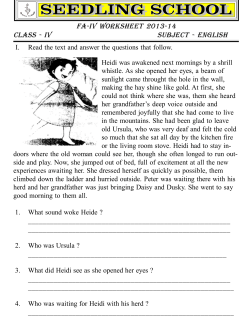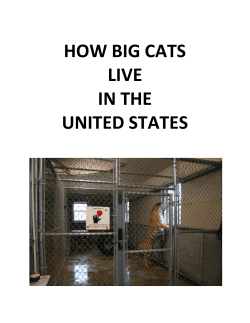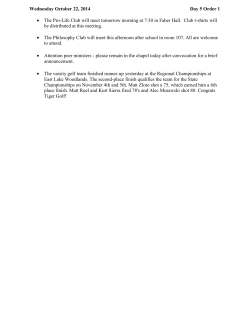
For active management towards rehabilitation of
STANDARD OPERATING PROCEDURE FOR ACTIVE MANAGEMENT TOWARDS REHABILITATION OF TIGERS FROM SOURCE AREAS AT THE LANDSCAPE LEVEL NATIONAL TIGER CONSERVATION AUTHORITY STANDARD OPERATING PROCEDURE FOR ACTIVE MANAGEMENT TOWARDS REHABILITATION OF TIGERS FROM SOURCE AREAS AT THE LANDSCAPE LEVEL NATIONAL TIGER CONSERVATION AUTHORITY MINISTRY OF ENVIRONMENT, FOREST & CLIMATE CHANGE GOVERNMENT OF INDIA STANDARD OPERATING PROCEDURE FOR ACTIVE MANAGEMENT TOWARDS REHABILITATION OF TIGERS FROM SOURCE AREAS AT THE LANDSCAPE LEVEL 1.Title: Standard Operating Procedure for active management towards rehabilitation of tigers from source areas at the landscape level. 2. Subject: Active management towards rehabilitation of tigers from source areas at the landscape level. 3. Reference: SOP of National Tiger Conservation Authority / Project Tiger to deal with straying tigers in human dominated landscapes and related advisories on the subject. 4. Purpose: With the increase in tiger numbers in India, there will be several areas where dispersing tigers will move through human dominated landscapes and at times result in human-tiger conflict. Conservation in such areas will now be dependent on quick, timely and appropriate mitigation of these conflict situations. Often tigers involved in conflict or tigers that come into human dominated landscapes may need to be captured. If such tigers are not man03 STANDARD OPERATING PROCEDURE FOR ACTIVE MANAGEMENT TOWARDS REHABILITATION OF TIGERS FROM SOURCE AREAS AT THE LANDSCAPE LEVEL eaters then there is a possibility to release them back into the wild. However, capturing tigers and releasing them to the source of their origin would not always resolve the problem. Often, the main reason for the dispersal of tigers is the high density of the source population. It is important to relocate such tigers to areas of low tiger density (or no tigers but have recorded tiger presence in the historical range), which have good habitat and prey populations. However, care needs to be taken to ensure that such relocations are done within population clusters that share a recent common gene pool. Based on the current genetic knowledge and existing corridor connectivity, we herein identify such population clusters within each landscape and suggest areas that are suitable to relocate surplus tigers. 5. Short summary: This Standard Operating Procedure (SOP) provides the basic criteria for Active management towards rehabilitation of tigers from source areas at the landscape level. 04 STANDARD OPERATING PROCEDURE FOR ACTIVE MANAGEMENT TOWARDS REHABILITATION OF TIGERS FROM SOURCE AREAS AT THE LANDSCAPE LEVEL 6. Scope: The SOP applies to all tiger landscapes / tiger reserves and tiger bearing forests. 7. Responsibilities: The Field Director would be responsible in the case of tiger reserves. For protected areas (National Park / Wildlife Sanctuary), the concerned protected area manager would be responsible. In the case of other areas (revenue land/conservation reserve /community reserve/village/township) the Wildlife Warden, as per the Wildlife (Protection) Act, 1972, or Divisional Forest Officer/ Deputy Conservator of Forests (under whose jurisdiction the area falls), would be responsible. The overall responsibility at the State level would rest with the Chief Wildlife Warden of the concerned State. 05 STANDARD OPERATING PROCEDURE FOR ACTIVE MANAGEMENT TOWARDS REHABILITATION OF TIGERS FROM SOURCE AREAS AT THE LANDSCAPE LEVEL Suggested field actions to deal with active management towards rehabilitation of tigers from source areas at the landscape level: 1. Shivalik Hills and Gangetic Plains Landscape (map on page 08-09) This landscape has high density source tiger populations like Corbett TR and other sources like Dudhwa NP, Kishenpur WLS, Katerniaghat WLS and Pilibhit TR. Tiger presence is now almost continuous from the Ganges eastwards into Nepal. The only low-density tiger habitat with appropriate prey density to support additional tigers is the western part of Rajaji NP, which includes the ranges of Dholkhand (East & West), Kansrao, Haridwar, Motichur, Ramgarh, and Chillawali. If tigers are relocated here, they are likely to breed and eventually spread into the Shivalik Forest division of Uttar Pradesh, and into Kalesar National Park of Haryana. The second option are the forests of Suhelwa WLS, which 06 STANDARD OPERATING PROCEDURE FOR ACTIVE MANAGEMENT TOWARDS REHABILITATION OF TIGERS FROM SOURCE AREAS AT THE LANDSCAPE LEVEL currently require restorative inputs, so as to boost prey populations, and protection measures to ensure that introduced tigers are not poached. Valmiki TR maintains good connectivity with the Chitwan NP in Nepal. Tigers dispersing from Valmiki TR should be put back into Valmiki as they have a large landscape to disperse into on the Nepal side. Parts of Chitwan NP and Parsa wildlife reserve have low tiger density and can potentially accommodate dispersers from Valmiki TR. Valmiki tigers could also be translocated to Sohagibarwa WLS (after ensuring adequate protection measures). Turn over for Map representing tiger bearing areas and their tiger densities in the Shivalik hills and Gangetic plains landscape (2013-14). The highlighted areas (in red) represent potential areas for relocating tigers within this landscape 07 STANDARD OPERATING PROCEDURE FOR ACTIVE MANAGEMENT TOWARDS REHABILITATION OF TIGERS FROM SOURCE AREAS AT THE LANDSCAPE LEVEL 2. Central Indian landscape 2.1 CI-Cluster I: Sariska TR, Ranthambore NP, Kailadevi WLS, Mukundara hills TR, Palpur-Kuno WLS, Madhav NP (map on page 11) For the northwestern cluster of the central Indian landscape, Ranthambore NP is the only high-density source population. It is well connected to low tiger density areas like Kailadevi WLS, Palpur-Kuno WLS and Mukundara hills TR, which are potential sites for moving dispersing tigers from Ranthambore NP. If tigers are relocated here, then this will facilitate the persistence of a healthy metapopulation in the landscape. Map representing tiger bearing areas and their tiger densities in CG-Cluster I (2013-14). The highlighted areas (in red) represent potential areas for relocating tigers within this landscape 10 STANDARD OPERATING PROCEDURE FOR ACTIVE MANAGEMENT TOWARDS REHABILITATION OF TIGERS FROM SOURCE AREAS AT THE LANDSCAPE LEVEL 2.2 CI-Cluster II: Bandhavgarh TR, Sanjay Dubri TR, Guru Ghasidas NP, Achanakmar TR, Kanha TR, Pench TR, Melghat TR, Satpura TR, Tadoba-Andhari TR, Nawegaon-Nagzira TR, Bor TR, Kawal TR, Indravati TR, Udanti-Sitanadi TR, Palamau TR, Nauradehi WLS, Panna TR (map on page 13) This cluster has several high-density source populations like Kanha TR, Pench TR, Tadoba-Andhari TR and Bandhavgarh TR. However, the connectivity in the interceding areas is very poor. The dispersing tigers from these populations could be moved into low tiger density areas of Sanjay Dubri TR, Guru Ghasidas NP, Achanakmar TR, Udanti-Sitanadi TR, Kawal TR, Indravati TR, Palamau TR and Nauradehi WLS. However, appropriate protection measures and prey base restoration needs to be addressed at these sites. Other additional sites where tigers from this central Indian cluster could be moved, are to the forests of Khandwa, Dewas, Harda, Betul and Burhanpur. Map representing tiger bearing areas and their tiger densities in CG-Cluster II (2013-14). The highlighted areas (in red) represent potential areas for relocating tigers within this landscape STANDARD OPERATING PROCEDURE FOR ACTIVE MANAGEMENT TOWARDS REHABILITATION OF TIGERS FROM SOURCE AREAS AT THE LANDSCAPE LEVEL 2.3 CG-Cluster III: Similipal TR and Satkosia TR Similipal and Satkosia TRs represent a lineage that produces melanistic tigers and are likely to be of a unique gene pool in this landscape. We therefore, need to maintain the genetic integrity of this landscape by refraining from relocating tigers from other areas of central India into this cluster. There is a vast area of suitable habitat in these areas, which currently harbours very low density of tigers. Any dispersing tiger out of these areas needs to be put back into Similipal and Satkosia TRs. However, the prey base, habitat and protection measures need to be improved and the reasons for the movement of the tigers need to be inspected. It may be relevant to commence a conservation breeding program for tigers from this cluster since their numbers are rapidly declining and this unique phenotype may become extinct in the future. 14 STANDARD OPERATING PROCEDURE FOR ACTIVE MANAGEMENT TOWARDS REHABILITATION OF TIGERS FROM SOURCE AREAS AT THE LANDSCAPE LEVEL 2.4 EG-Cluster I: Nagarjunsagar-Srisailam TR, Gundla Bramheshwaram WLS (map on page 16-17) The only source population in this cluster is the Nagarjunsagar-Srisailam TR, while there are several protected areas with suitable prey base and habitat such as Sri Lankamalleswara WLS, Sri Penusila Narasimha WLS and Sri Venkateswara NP in the Eastern Ghats, which currently do not have any tiger population. Forest corridors connect Srisailam forests with those of Siddavatam and Sri Venkateswara NP, and by relocating tigers into Sri Venkateswara NP, it will help expand tiger occupied areas and create new source populations. Tigers from the above forests are likely to disperse and occupy Siddavatam, Kurnool, Prakasham and Cuddappah forests as well. One major concern that needs to be addressed/studied in these areas is the presence of appropriate prey base and relevant protection. 15 16 Map representing tiger bearing areas and their tiger densities in EG-Cluster I (201314). The highlighted areas (in red) represent potential areas for relocating tigers within this landscape 17 STANDARD OPERATING PROCEDURE FOR ACTIVE MANAGEMENT TOWARDS REHABILITATION OF TIGERS FROM SOURCE AREAS AT THE LANDSCAPE LEVEL 3. Western Ghats Landscape complex 3.1 WG-Cluster I: Sahyadri TR, Protected areas of Goa (Mhadei WLS, Bhagawan Mahavir (Mollem) NP, Netravali WLS, Cotigaon WLS), Dandeli-Anshi TR, Bhadra TR, Bandipur TR, Nagarhole TR, Biligiri Ranganatha Temple TR (BRT), Sathyamangalam TR and Mudumalai TR (map on page 20-21) The Western Ghats landscape has several high-density source populations like Bandipur TR, Nagarhole TR and BRT TR and the populations here are likely to disperse out in the near future. Repopulating these dispersing tigers to intervening low tiger density areas like Bhadra TR and Dandeli-Anshi TR will connect these populations to other lowdensity areas like Sahyadri and Goa where ample tiger habitat exists but tigers are at low density. This will also create a contiguous tiger population with ample connectivity, which is important for longterm survival of these populations. Followed by Bhadra TR and Dandeli-Anshi TR, the 18 STANDARD OPERATING PROCEDURE FOR ACTIVE MANAGEMENT TOWARDS REHABILITATION OF TIGERS FROM SOURCE AREAS AT THE LANDSCAPE LEVEL protected areas of Goa and Sahyadri TR form a viable option in this cluster to move dispersing tigers. 3.2 WG-Cluster II: Parambikulam TR, Anamalai TR, Periyar TR, KalakadMundanthurai TR (KMTR) The second cluster of the Western Ghats landscape complex currently has low density of tigers, and any dispersing tigers in this cluster can be put back into their respective tiger reserves and the reason for their movement into human dominated landscapes needs to be examined. 19 Map representing tiger bearing areas and their tiger densities in WG-Cluster I (2013-14). The highlighted areas (in red) represent potential areas for relocating tigers within this landscape STANDARD OPERATING PROCEDURE FOR ACTIVE MANAGEMENT TOWARDS REHABILITATION OF TIGERS FROM SOURCE AREAS AT THE LANDSCAPE LEVEL 4 Northeast hills and Brahmaputra flood plains (map on page 23) 4.1 NE-Cluster I: Kaziranga TR, Manas TR, Orang NP, Buxa TR, Nameri TR, Pakke TR, Dampa TR, Karbi Anglong hills, Gorumara NP and Jaldapara WLS, Intaki NP. The source populations that currently produce dispersing tigers within this cluster are Kaziranga and Orang TRs. Surplus wild tigers could be relocated into Manas TR, Buxa TR, Gorumara NP, Jaldapara WLS, Dampa TR, and the Karbi Anglong Hills. However, these areas need to ensure protection for the introduced tigers. 4.2 NE-Cluster II: Namdapha TR and Dibang WLS Tiger populations from this extremely eastern population cluster are likely to have their genetic affinity with tigers from Myanmar. Tigers from this cluster should be moved within this region only. Since this is a low tiger density area, conflicts with conspecifics are unlikely to occur. 22 Map representing tiger bearing areas and their tiger densities in NE-Cluster I (2013-14). The highlighted areas (in red) represent potential areas for relocating tigers within this landscape STANDARD OPERATING PROCEDURE FOR ACTIVE MANAGEMENT TOWARDS REHABILITATION OF TIGERS FROM SOURCE AREAS AT THE LANDSCAPE LEVEL 5 Sundarbans Landscape: (map on page 26) The tiger population of the Sundarbans is phenotypically unique and specifically adapted to life in the mangrove forests. Tigers dispersing out of this habitat need to be restored either in the Sundarbans or in zoos. No tigers from any other cluster should be introduced into Sundarbans nor should tigers from Sundarbans be introduced elsewhere. The recent tiger estimation (2014) has shown areas of low density within the Sundarban Biosphere Reserve. These maps can be used to guide field managers in releasing captured Sundarban tigers back into the wild. Tigers that kill humans accidentally need to be treated differently from those that have become man-eaters. Man-eaters need to be removed immediately and should not be reintroduced into free ranging conditions. While tigers that have come into conflict situations accidentally can be captured and reintroduced into vacant/ low-density habitats. Preferably, tigers that are released after relocation should be equipped with satellite telemetry collars so that they can be 24 STANDARD OPERATING PROCEDURE FOR ACTIVE MANAGEMENT TOWARDS REHABILITATION OF TIGERS FROM SOURCE AREAS AT THE LANDSCAPE LEVEL tracked remotely. Incase such tigers continue to be problem animals they should be recaptured and put in captivity or eliminated. Release into new area should preferably be done by soft release protocol. Hard release should only be considered when logistic constraints do not permit soft release. The release site should have good habitat, prey density and protection measures. Human density at the release site should be low and composed of communities that have experience of living with large carnivores. Turn over for Map representing tiger bearing areas and their tiger densities in Sundarbans (2013-14). The highlighted areas (in red) represent potential areas for relocating tigers within this landscape 25 STANDARD OPERATING PROCEDURE FOR ACTIVE MANAGEMENT TOWARDS REHABILITATION OF TIGERS FROM SOURCE AREAS AT THE LANDSCAPE LEVEL NB:1. The identification of dispersing tiger and the procedure for translocation / drug dosage / transportation would be in accordance with guidelines / SOP issued earlier from NTCA / Project Tiger. 2. Adequacy of field protection / prey base should be ascertained at the new site prior to translocation. 3. 'Soft' release of the tiger should be preferred as a precautionary measure, which would necessitate the creation of an in-situ enclosure with natural prey at the release site. 4. The translocated tiger should invariably radio collared to facilitate close monitoring after release. 27 STANDARD OPERATING PROCEDURE FOR ACTIVE MANAGEMENT TOWARDS REHABILITATION OF TIGERS FROM SOURCE AREAS AT THE LANDSCAPE LEVEL NOTES 28
© Copyright 2025









